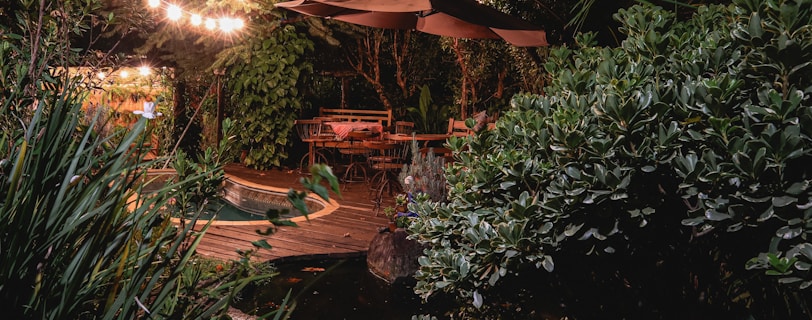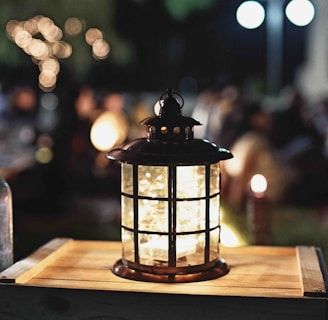Solar Lighting for any Yard
Learn the essentials of choosing, installing, and maintaining solar lights to brighten your exterior efficiently and sustainably. Elevate your outdoor living with solar-powered lighting designed for efficiency and ease.
HOME GUIDESOL GEAR
8 min read


We delve into selecting the right solar lights for your space, whether it’s a vast yard or a cozy nook. Installation tips and maintenance practices ensure your lights perform optimally, enhancing your home’s appeal and functionality.
"An Inverter Is Not Necessary for Most Solar Light Installations"
Solar Lighting Solutions for Every Outdoor Space: Yard and Garden
Solar energy lights offer homeowners a green and cost-effective way to illuminate their outdoor living spaces. From yards to patios, these lighting solutions harness the sun's power, providing a renewable source of light after dusk. Solar energy lights are not only environmentally friendly but also significantly reduce electricity bills by minimizing grid power consumption. With a variety of designs ranging from pathway lights to decorative string lights, they cater to diverse aesthetic preferences, enhancing the beauty of outdoor areas. Additionally, their easy installation and low maintenance requirements make them an ideal choice for homeowners looking to add lighting without the hassle of complex wiring or frequent bulb replacements.
Solar lights typically contain LED bulbs powered by built-in batteries, charged by solar panels during the day, eliminating the need for complex wiring or inverters. Each solar light unit is a self-contained system: photovoltaic cells capture sunlight, converting it directly into electrical power stored in batteries. These lights automatically turn on at dusk, offering convenience and energy savings.
When choosing solar lights for your outdoor space, consider brightness (lumens), light color, and battery life. Opt for lights with motion sensors for pathways and LED bulbs for long-lasting illumination. Furthermore, assess the durability and weather resistance of the solar lights to ensure they can withstand your local climate conditions, from intense sun to heavy rain. It's also beneficial to select lights with adjustable settings, allowing you to customize brightness levels and lighting schedules to suit your specific outdoor lighting needs.
We Recommend This Waterproof Lawn Solar Lighting
Strategic placement maximizes sunlight exposure, ensuring solar panels charge efficiently. Avoid shaded areas to prevent battery drainage and ensure consistent lighting performance.
Utilize Reflective Surfaces: Place solar lights near surfaces that reflect sunlight, like white walls or light-colored stones, to enhance indirect sunlight exposure for improved charging.
Leverage Landscape Features: Integrate solar lights with existing landscape features, such as under garden sculptures or alongside water features, to create dramatic lighting effects while ensuring they receive ample sunlight.
Adopt Seasonal Adjustments: Adjust the positioning of your solar lights seasonally to account for the changing path of the sun, ensuring they continue to receive optimal light as the seasons change.
Incorporate Timer Controls: Utilize solar lights with timer functionalities to conserve energy, ensuring lights are only on when needed, extending battery life and improving efficiency.
Experiment with Elevation: Elevate solar lights on posts or hang them from trees where they can catch unobstructed sunlight, offering a dual advantage of better charging and a unique aesthetic perspective.
Opt for Hybrid Placement: Combine freestanding solar lights with those attached to structures to diversify your lighting scheme and guarantee at least some lights perform well regardless of ground shading.
Balance Function and Form: While arranging lights for aesthetics, also consider their functional purpose, like illuminating walkways clearly, to ensure safety alongside beauty.
Implement Redundant Lighting: Place multiple lights in crucial areas as a backup measure, ensuring that if one light’s performance dips, others can compensate for adequate illumination.
Selective Shading for Evening Use: Interestingly, slightly shaded areas can be strategic for lights intended for use at dusk rather than immediately after sunset, balancing ambiance with practicality.
Monitor and Mitigate Wear: Regularly inspect not just for cleanliness and battery life, but also for wear on the solar panels and light housing to prevent gradual degradation of light quality and charging capacity.
Adapting to Environmental Dynamics in Outdoor Spaces:
Microclimate Adaptation for Garden Lights: Gardens often have microclimates affecting temperature and light exposure. Implement adaptive lighting strategies, such as choosing lights with materials that withstand temperature fluctuations and strategically placing lights where they receive consistent sunlight throughout the day.
Lawn Lighting Placement for Optimal Sun Exposure: For lawns that require regular mowing, position solar lights in a way that maximizes sun exposure while ensuring they're not obstructed by grass growth or yard activities. Consider elevated or stake-mounted lights that can be easily moved or adjusted.
Leveraging Technology for Enhanced Efficiency:
Smart Solar Lighting Systems: Invest in smart solar lights equipped with sensors and timers for gardens and lawns. These systems can adjust brightness based on the time of day or motion detection, conserving energy and extending battery life.
Automated Light Positioning: For critical areas, use solar lights with adjustable panels. This feature allows for minor adjustments to panel orientation throughout the seasons, maintaining optimal charging even as the sun's position changes.
Maintaining Peak Efficiency in Solar Lighting Systems:
Routine Cleaning and Maintenance: Keep solar panel surfaces clean and free from debris to ensure maximum light absorption. In gardens, ensure that nearby plants do not overgrow and shade the solar panels.
Upgrading for Better Performance: Stay informed about the latest in solar lighting technology. Upgrading older lights to newer, more efficient models can significantly enhance your garden or lawn's nighttime ambiance.
Customizing Solar Lighting for Unique Garden and Lawn Needs:
Strategic Light Placement for Aesthetic and Functional Benefits: Place solar lights to highlight garden features or illuminate walkways. The right placement not only enhances the beauty of the space but also contributes to the safety and functionality of your outdoor areas.
Expansion for Comprehensive Coverage: If your outdoor lighting needs grow, consider expanding your solar lighting setup. Adding additional lights or integrating lights with different functions (e.g., spotlights for trees or accent lights for pathways) can create a more dynamic and efficient outdoor lighting system.
Harnessing Smart Solar Lighting Solutions:
Automated Lighting Systems: Implement solar lighting systems equipped with timers and motion sensors to automate operation based on time of day or movement, enhancing energy efficiency and providing light only when needed.
Remote Control and Customization: Look for solar lighting options that offer remote control capabilities, allowing you to adjust lighting modes and settings without manual intervention, perfect for creating specific moods for events or adjusting for seasonal changes.
Ensuring Successful Installation of Solar Lighting in Gardens and Lawns
Installation List and Considerations
Selection Criteria
Solar Lights: Brightening Yards and Beyond


Solar Yard Lights on Amazon
Illuminating Your Lawn: Aesthetic Enhancements with Solar Lighting
Using solar lighting effectively is not just about illuminating your outdoor space; it's an art that enhances the beauty and ambiance of your lawn. Thoughtful placement and selection of solar lighting can transform a simple lawn into a captivating landscape. Here’s how to achieve that picturesque look:
Accentuate Key Features: Identify the unique features of your lawn that deserve spotlighting. It could be a majestic old tree, a sculptural installation, or a water feature. Use solar spotlights to cast a focused light on these elements, creating dramatic shadows and highlights that draw the eye and add depth to your lawn at night.
Pathway Lighting for Function and Beauty: Solar pathway lights offer a practical solution for navigating your outdoor space after dark, but they also provide an opportunity to add charm. By placing lights at regular intervals along walkways, you can create a welcoming, fairy-tale-like ambiance that invites exploration. Shoot for designs that complement your lawn’s style, whether it's modern minimalism or rustic charm.
Soft Lighting for Texture and Depth: Utilize solar lights with soft, warm glows to add texture and depth to your lawn. Positioning these lights among flower beds or under shrubbery can illuminate the textures of plants and ground cover, giving your lawn a lush, vibrant appearance. This technique also helps to soften the landscape, making the space feel more inviting.
Layered Lighting for Dimension: Implement a layered lighting approach by combining various types of solar lights at different heights and intensities. Mix tall, standing lights with lower pathway markers and accent lights. This creates a sense of dimension and visual interest, making your lawn feel more dynamic and spacious.
Shadow Play for Dramatic Effect: Use the interplay of light and shadow to add drama to your lawn. Place lights near fencing or plants to cast intriguing shadows on open spaces of your lawn. This not only highlights the natural beauty of your outdoor space but also adds an element of mystery and intrigue after sundown.
Creating Gathering Spaces: Illuminate areas of your lawn designated for gathering, such as seating areas or fire pits, with ambient solar lighting. This not only makes these spaces usable at night but also creates a cozy, inviting atmosphere for evening socializing. Consider solar string lights or lanterns for a soft, diffuse light that enhances the social ambiance.
By thoughtfully integrating solar lighting into your lawn, you can elevate its night-time appeal, creating an outdoor space that's as functional as it is beautiful. Solar lights offer the flexibility to experiment with different arrangements and styles, allowing you to customize the look and feel of your lawn to match your personal aesthetic and make it a true extension of your home.


For our Artice on Using or Getting a Solar Generator
If Interested in Maximizing Solar Electric Efficiency
Economic Benefits of Outdoor Yard Solar Lighting
Beyond environmental advantages, solar outdoor lighting presents considerable economic benefits. Initial setup costs are quickly offset by the elimination of ongoing electricity bills associated with outdoor lighting, coupled with low maintenance requirements. Solar lights, equipped with LEDs, offer long service life, reducing the need for frequent replacements and further enhancing their cost-effectiveness and efficiency in energy use.
The installation of solar lights improves property aesthetics and safety, potentially increasing property value and curb appeal. Strategically placed lights enhance the visual appeal of gardens and walkways, while providing illumination that deters trespassers and reduces accident risks. This dual function of beautification and security adds intrinsic value to homes, making solar outdoor lighting an advantageous investment for homeowners.
The savings potential of solar outdoor lighting can be significant, with homeowners potentially reducing their outdoor lighting energy costs to virtually zero after the initial purchase and installation. Over the lifespan of solar lights, which can range from 4 to 7 years depending on the quality and usage, the cost savings are amplified when compared to traditional electric lighting solutions. For example, replacing five 60-watt outdoor light fixtures with solar lights, assuming an average of 5 hours of operation per day, can save homeowners around $100 to $200 annually on their electricity bills, depending on local energy rates. This calculation doesn't even account for the reduced maintenance and replacement costs, as solar LED bulbs have a longer lifespan than conventional bulbs, further contributing to the overall savings over time.


We Recommend These Lawn and Sidewalk Solar Lights for Night Visibility
To support our work, we may earn a commission when you buy through links on our site. As an Amazon Associate, I earn from qualifying purchases.
Cookie Notice: Our website uses cookies to enhance your browsing experience. By continuing to use our site, you agree to our use of cookies. If you wish to manage your cookie preferences, you may do so in your browser settings.
To support our work, we may earn a commission when you buy through links on our site. As an Amazon Associate, I earn from qualifying purchases.This page may contain affiliate links, which means if you click through and make a purchase, we may receive a commission at no additional cost to you. This helps support our research and editorial team.




